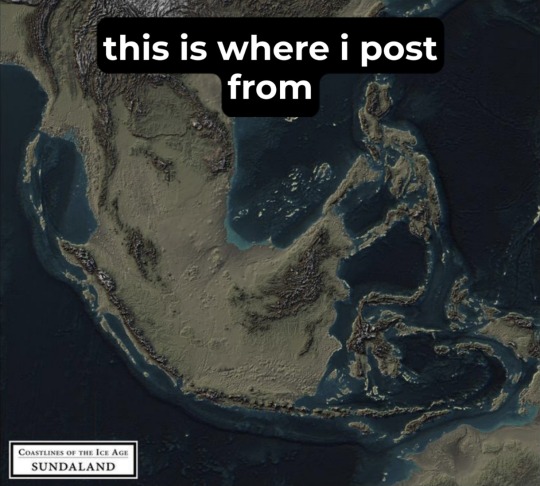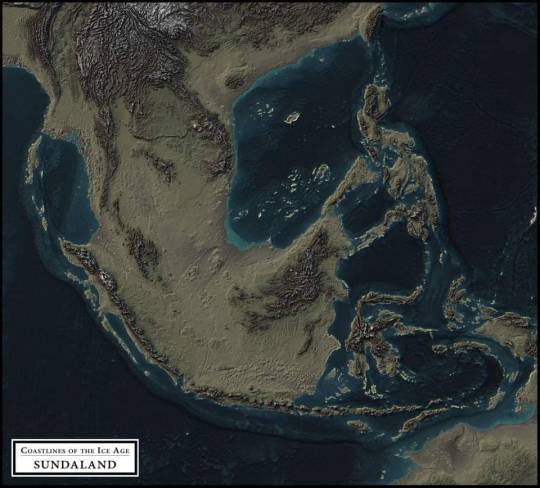#sundaland
Explore tagged Tumblr posts
Text
In northern Palawan two tiger subfossils were found during archaeological excavations at Ille Cave near the village of New Ibajay, as reported by Philip Piper and colleagues … Piper and colleagues take the tiger bones as evidence of a viable tiger population in Palawan. However, tiger claws are widely used as amulets in the whole of South and Southeast Asia where tigers occur, a practice carried out in earlier centuries, as pointed out by Van der Geer. Furthermore, the condition of the tiger subfossils differs from that of the other fossils, as they show longitudinal cracking of the cortical bone surfaces due to weathering, indicating a post-mortem exposure to air and light. In addition, slight damage is present at several places, and partial concretion occurs on one of the condyles. Piper and colleagues are aware of the 'ornamental' (magic) value of tiger skins and teeth, and admit that these can be transported over long distances, but they overlook tiger claws and jugular bones, which are widely used as well. The tiger subfossils might thus very well have been imported by the human settlers. Such was the case with the tiger canine found in 10th to 12th century Ambangan sites in Butuan, Mindanao, as explained by Elenita Alba. On the other hand, admittedly, Palawan is not far away from Borneo, and tigers are known to be excellent swimmers. A few tiger remains have also been reported from Borneo, being two subadult canines and a metacarpal fragment (Niah Caves) and a navicular bone (Madai Cave), from large latest Pleistocene and Early Holocene vertebrate assemblages. The conclusion that there was a viable tiger population in Palawan during the latest Pleistocene and early Holocene.
Excerpt from “Evolution of Island Mammals: Adaptation and Extinction of Placental Mammals on Islands” (2011) by Alexandra van der Greer et al.
#philippines#palawan#borneo#southeast asia#sundaland#panthera tigris#flora and fauna#prehistory#last ice age#x
8 notes
·
View notes
Text

2 notes
·
View notes
Photo

Coastlines of the Ice Age Sundaland,
432 notes
·
View notes
Photo

July 🌞 #sundaland https://www.instagram.com/p/CQyqmhqADRb/?utm_medium=tumblr
0 notes
Text
In Focus: Biodiversity Hotspots
In Focus: Biodiversity Hotspots
In Focus: Biodiversity Hotspots A biodiversity hotspot is a region with a high amount of biodiversity that experiences habitat loss by human activity.The term “biodiversity hotspot” was coined by a British environmentalist Norman Myers in 1988.For a region to qualify as a biodiversity hotspot, it must meet the following two criteria:Contain at least 1,500 species of vascular plants found nowhere…

View On WordPress
#Biodiversity Hotspots concerning India#IAS#Indo-Burma region#Sundaland#The Himalayas#upsc#Western Ghats
1 note
·
View note
Text
Sundaland home of atlantis

1 note
·
View note
Photo

Am #javanese girls at #sundaland #eits
0 notes
Video
vimeo
Spring 2017 Collection | Sundaland
0 notes
Text
SUNDALAND (Agenda Badag 2014)
Welcome back~ kembali bersamaku di throwback memories season agenda badag. Oiya agenda badag merupakan event andalan unit LSS yang memperkenalkan kebudayaan Sunda lewat beberapa variasi acara. Acara ini berlangsung setiap 2 tahun sekali. Beberapa kesenian khas yang ditampilkan diantaranya adalah Bubuka, Kapsulwih, Klasik, RPKD, Jaipong, serta Longser.
24 Juni 2014
Aku sampai di kampus pagi sekitar pukul 9. Setelahnya aku segera mengganti bajuku dengan baju panitia yang telah dibagikan. Siang harinya, kami para pamen kesenian menjaga stand-stand yang ada. Kebetulan aku mendapat tugas menjaga wahana labirin bersama temanku Laisa. Senangnya saat itu melihat para pengunjung yang antusias dan memenuhi wahana. Aku yang saat itu menjaga wahana berusaha semempuku untuk menggunakan bahasa Sunda, sayangnya karna belum terlalu lancar aku pun kena tegur oleh salah seorang ibu-ibu pengunjung yang hadir*maluuuu.Setelahnya aku kembali berkumpul bersama skuad Merakku di lapcin sembari menikmati permen dan foto-foto menunggu arahan berikutnya.

Tidak terasa sore hari telah datang. Saatnya kami bersiap-siap untuk fokusing terpusat serta mengganti kostum kami. Namun, something bad happened to me!!! Tiba-tiba saat aku ke wc dan melihat bayanganku di kaca, mataku bengkak dan gatal tanpa sebab. Panik aku pun mencari teteh-teteh medik. Untungnya saat itu ada Ka Alda yang siap sedia memberikanku air hangat untuk mengurangi rasa gatal dan menemaniku di perempatan cc barat. Beberapa saat sebelum Maghrib hujan mengguyur kota Bandung termasuk lapbas tempat kami akan tampil. Waditra yang telah siap di atas panggung terpaksa kami tutupi terpal dan dibereskan. Semua wargi panik dan berharap agar langit berpihak pada kita. Dan ternyata langit pun mendukung dengan berhentinya hujan tepat sebelum acara dimulai. Para wargi segera bahu-membahu mempersiapkan panggung dan bersama-sama membersihkan lapbas.
Usai fokusing kami segera ke ruang mektum dan berganti kostum. Mata bengkak ini sungguh mengganggu, untungnya make-up yang ada menutupi kejanggalan di salah satu sisi wajahku itu. Saat kami di ruang make up. Bubuka telah tampil, sayangnya kami hanya bisa mendengar alunan suara waditra pelog yang terdengar hingga ke basement cc barat. Dari suara tepukan tangan penonton, dapat ditebak bahwa banyak sekali pengunjung yang hadir. Semakin lama area lapbas penuh dengan penonton hingga ke bagian Boulevard.

Bubuka uwow~
Penampilan Bubuka meriah abis. Penampilan kesenian yang satu ini emang mampu menawan hati penonton. Mulai dari suara goong & piiw yang bikin deg-degan kalo didengerin (hikmat banget suasana pembukanya mantap), gugunungan yang gagah, hingga panari yang keliatan banget chemistrynya. Setelah bubuka ada kapsulwih nih. Suara trio pangawih yang merdu bikin setiap hati adem deh dijamin. Dilanjutkan dengan penampilan calung unyu unyu dari anak-anak panti.

Trio pangawih

Lucu banget ya ga sih??
Selama kapsulwih tampil, aku dan skuad merak lainnya udah siap-siap di backstage sambil sesekali mengintip ke balik layar. Saat tiba saatnya kami dipanggil, kami segera memasuki panggung dan menaiki tangga yang ada. Jujur deg-degan banget nih. Aku makin kaget pas liat posisi mic yang menghalangi pukulan supir bisku pas pembukaan penampilan. Saat awal aku bisa santai namun ntah kenapa di variasi 2 tiba-tiba ingatan hafalanku ketuker jadi weeh agak aneh. Hal ini bahkan mempengaruhi tmn-tmn nayaga yang lain khususnya partner boncik aku yaitu Dista. Sadar salah sontak aku berusaha ga panik dan menstabilkan diri. Jujur aja aku ngerasa bersalah banget dan akhirnya nangis pas kesan pesan dpn cc barat. Ngerasa penampilan akhir ini...ruined everything...gomenasai cingu :((. Selain itu ternyata ada masalah lain. Palatih ngerasa kecewa banget sama lighting yang kurang pas. Tapi setelah tampil antara senang & sedih sih.Sedihnya karena aku kurang maksimal di akhir penampilan & bakal pisah sm skuadku yg satu ini (kapan lagi kita bakal setim dengan org yg sama :’‘‘). Seneng karena ini penampilan perdanaku selama kuliah :))


Us, KURA-KURA :))
Setelah kami penampilan berikutnya tidak kalah menarik yakni adanya RPKD, Jaipong & Longser yang buat suasana penampilan di malam ini makin hangat apalagi ditemani dengan caang bulan yang cantik banget.

repekade

Teteh-teteh Jaipong yang enerjik abis

Longser yang setia menemani sampai selesai acara
Daaaaaan acara ditutup dengan sautan jargon semangat dari Danlap kita Kang Ibnu (STI’12) serta euforia bareng...


Sundaland!!!
0 notes
Photo

The Prewedding of Annisa & Dylan ______________________ _______________________________ Contact us: WA +62-85793667789 Line @QEU1635X Email [email protected] ______________________________________________________ Makeup by @rianisetiani_mua ______________________________________________________ #prewedding #preweddingbandung #preweddbandung #preweddingjakarta #bandungjuara #weddinginspiration #weddingbali #preweddingsukabumi #weddingbogor #genpijabar #weddingmakeupbandung #bridestory #storyoflove #inspirasiprewedding #weddingsukabumi #weddingjakarta #weddingbandung #tasikmahgaya #mywed #muabandung #sukabumi #bandungbanget #visitbandung #weddingorganizerbandung #weddingjogja #inspirasiwedding #explorebandung #bdgsociety #sundaland #sundalandstudio (at Sukabumi)
#sundaland#weddinginspiration#bandungjuara#tasikmahgaya#weddingorganizerbandung#inspirasiwedding#storyoflove#preweddingjakarta#mywed#explorebandung#sukabumi#weddingbali#bandungbanget#preweddingbandung#sundalandstudio#weddingjogja#bdgsociety#inspirasiprewedding#preweddingsukabumi#prewedding#weddingsukabumi#weddingbogor#weddingmakeupbandung#bridestory#weddingjakarta#muabandung#visitbandung#genpijabar#preweddbandung#weddingbandung
0 notes
Photo

Sundaland, the lowlands of the greater Southeast Asian Peninsula
Sundaland (the lowlands of the greater Southeast Asian Peninsula) is the current name applied to the largest single section of Asian real estate submerged by rising sea levels after the last Ice Age. This area when above water would have been twice the size of India, and included what we now call Indo-China, Malaysia and Indonesia. The South China Sea, the Gulf of Thailand and the Java Sea, formed the connecting parts. There are also sunken tracts of Pacific coastline, which once covered the East China and Yellow Seas, and linked China, Japan, Korea and Taiwan. Apparently, the present location of Hong Kong and other Chinese ports were “hundreds of miles inland during the last Ice Age.
82 notes
·
View notes
Photo




Klasik dari masa ke masa
Merak yang suasananya semarak
Kandagan yang membuat hati deg-degan
Darmayu yang unyu-unyu
Baper and baper again~
0 notes
Text
Goodbye June!
Ini salah satu momen paling berharga di bulan Juni.

Sundaland, 14 Juni 2014.

Thank you, June! Best month in 2014 so far :')
0 notes